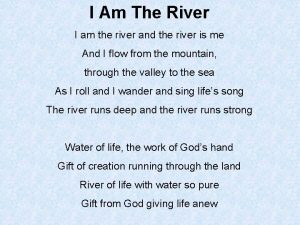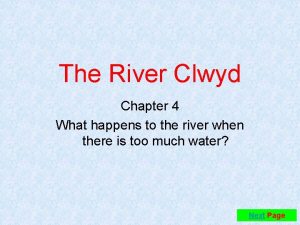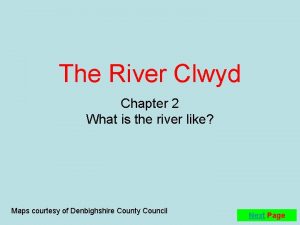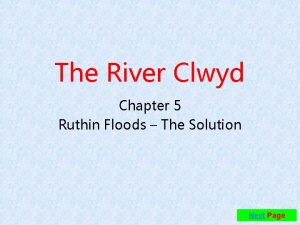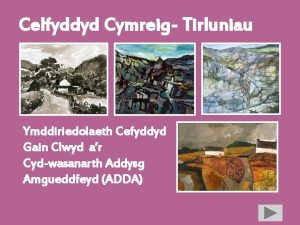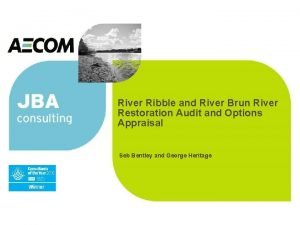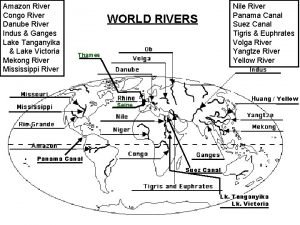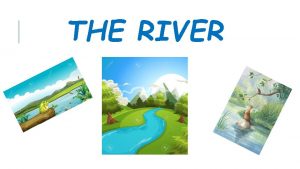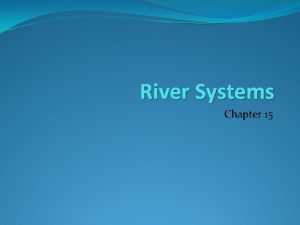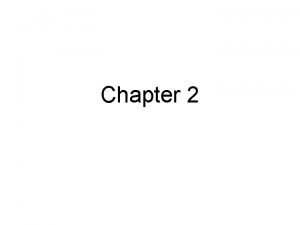The River Clwyd Chapter 3 Does the river



















- Slides: 19

The River Clwyd Chapter 3 Does the river change over time? Next Page

Does The River Clwyd change over time? To help answer this question we are going to look at a short section of the river between Denbigh and St. Asaph, near Llanerch Hall. We are going to look at an old map from 1880 and a new map from 2004 and see if the river has changed over this period. Next Page

This is how the river looks today. Take a good look at the course of the river. Click on the red circle and it will follow the course of the river. Next Page

This is how the river used to look. Can you see any changes? Click on the red circle and it will follow the course of the river. Next Page

To help you see the changes the river on the old map has been coloured red. When you click on this writing the map of today's river will go over the old map. Can you see how the river has changed? © Crown copyright. All rights reserved. Denbighshire County Council. 100023408. 2006. © Hawlfraint y Goron. Cedwir pob hawl. Cyngor Sir Ddinbych. 100023408. 2006. Next Page

In 2 places the river has taken a straighter course. The meanders are gone. © Crown copyright. All rights reserved. Denbighshire County Council. 100023408. 2006. © Hawlfraint y Goron. Cedwir pob hawl. Cyngor Sir Ddinbych. 100023408. 2006. Next Page

© Crown copyright. All rights reserved. Denbighshire County Council. 100023408. 2006. © Hawlfraint y Goron. Cedwir pob hawl. Cyngor Sir Ddinbych. 100023408. 2006. These 2 old sections of river are known as Oxbow Lakes. Next Page

What has caused this to happen? To understand we need to know about three different processes. 1. Erosion 2. Transportation 3. Deposition The three processes are really quite complicated but we will take a basic look at them. Next Page

Erosion is the wearing away of the bottom or sides of the river. This can be caused by: Discuss the picture. What can you see? 1. the force of the water (think of pointing a hosepipe at some soil – what happens to the soil? ) 2. rocks and stones rolling along the bottom. These wear away the bottom. The force of the water can sometimes move even large rocks. 3. items floating in the river which can knock against the banks and wear it away. Next Page

Erosion The water has worn away the bank. You can see that the grass used to be growing on the bank but is now hanging over the water. In order to do this the water must have got higher and therefore it must have happened after a lot of rain. The river would be deeper and flow faster and therefore have more force. Next Page

Transportation The river is able to transport or carry objects from an area that has been eroded further upstream. 1. Objects can float on the rivers surface e. g. leaves or wood. 2. Soil or sand can be carried within the river. After very heavy rain the river can look dirty and this is because of the load it is carrying. 3. The force of the water can also roll stones and rocks along the bottom. Next Page

Deposition This is the river dropping the load that it has transported. This will happen when the force of the water is not strong enough to carry the load any more. Heavy objects will be deposited first and the lightest last. Floating objects will be the last to be deposited. Can you see anything in the picture to suggest deposition? Next Page

Deposition Small pebbles Sand Plastic Wood Next Page

Use the terms Erosion (Eroded), Transportation (Transported) and Deposition (Deposited) to discuss the pictures on this slide. Next Page

Before we go any further you will notice that the outside of this bend in the river is eroded and the inside of the bend has pebbles etc. deposited on it. Outside Inside Next Page

Back to Oxbow Lakes! Now you know the 3 principles: Erosion, Transportation and Deposition, You are ready to see why the river changes and Oxbow lakes are formed. Click on the website below. www. school-portal. co. uk/Group. Download. File. asp? file=21606 Next Page

The Erosion of banks and the formation of oxbow lakes causes problems e. g. • a farmer losing land on one side of a river and the farmer on the other side gaining land. Which one is happier? • the bank near a building could wear away and the building fall in the river and therefore in some places people take action to prevent erosion. What do you think they could do? Next Page

How to stop erosion. To stop erosion you can support the bank with materials that are more difficult to erode. In the top example they have built a stone wall. In the example on the side they have put large stones on the bank. Trees and their roots also hold the bank together. Next Page

Here a map and some photos of the River Clwyd coming into Ruthin. Can you explain what has happened in the last few years? Can you explain what they have done in one place to stop it happening again? Old river course (in yellow) New river course (in red) Maps and aerial photo of river. Back to beginning © Crown copyright. All rights reserved. Denbighshire County Council. 100023408. 2006. © Hawlfraint y Goron. Cedwir pob hawl. Cyngor Sir Ddinbych. 100023408. 2006.
 Green river (duwamish river tributary)
Green river (duwamish river tributary) I am the river and the river is me
I am the river and the river is me Hát kết hợp bộ gõ cơ thể
Hát kết hợp bộ gõ cơ thể Frameset trong html5
Frameset trong html5 Bổ thể
Bổ thể Tỉ lệ cơ thể trẻ em
Tỉ lệ cơ thể trẻ em Voi kéo gỗ như thế nào
Voi kéo gỗ như thế nào Chụp tư thế worms-breton
Chụp tư thế worms-breton Bài hát chúa yêu trần thế alleluia
Bài hát chúa yêu trần thế alleluia Các môn thể thao bắt đầu bằng tiếng đua
Các môn thể thao bắt đầu bằng tiếng đua Thế nào là hệ số cao nhất
Thế nào là hệ số cao nhất Các châu lục và đại dương trên thế giới
Các châu lục và đại dương trên thế giới Công thức tiính động năng
Công thức tiính động năng Trời xanh đây là của chúng ta thể thơ
Trời xanh đây là của chúng ta thể thơ Mật thư anh em như thể tay chân
Mật thư anh em như thể tay chân Làm thế nào để 102-1=99
Làm thế nào để 102-1=99 Phản ứng thế ankan
Phản ứng thế ankan Các châu lục và đại dương trên thế giới
Các châu lục và đại dương trên thế giới Thơ thất ngôn tứ tuyệt đường luật
Thơ thất ngôn tứ tuyệt đường luật Quá trình desamine hóa có thể tạo ra
Quá trình desamine hóa có thể tạo ra

